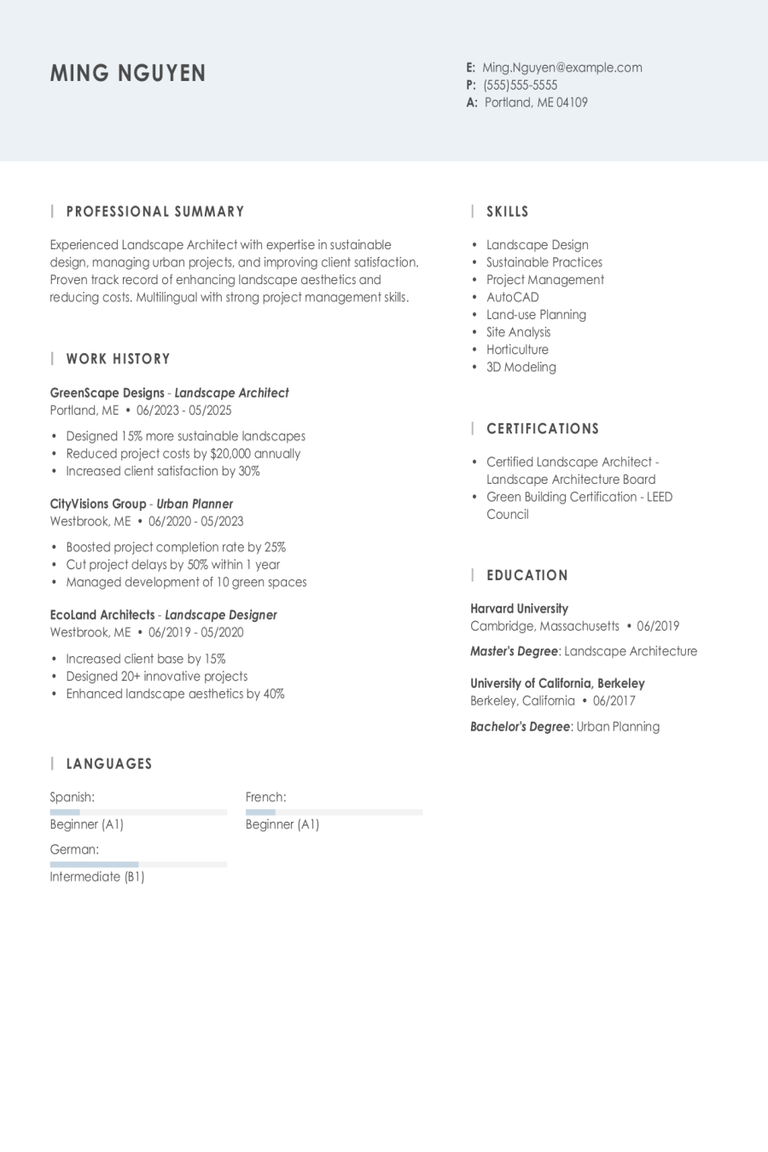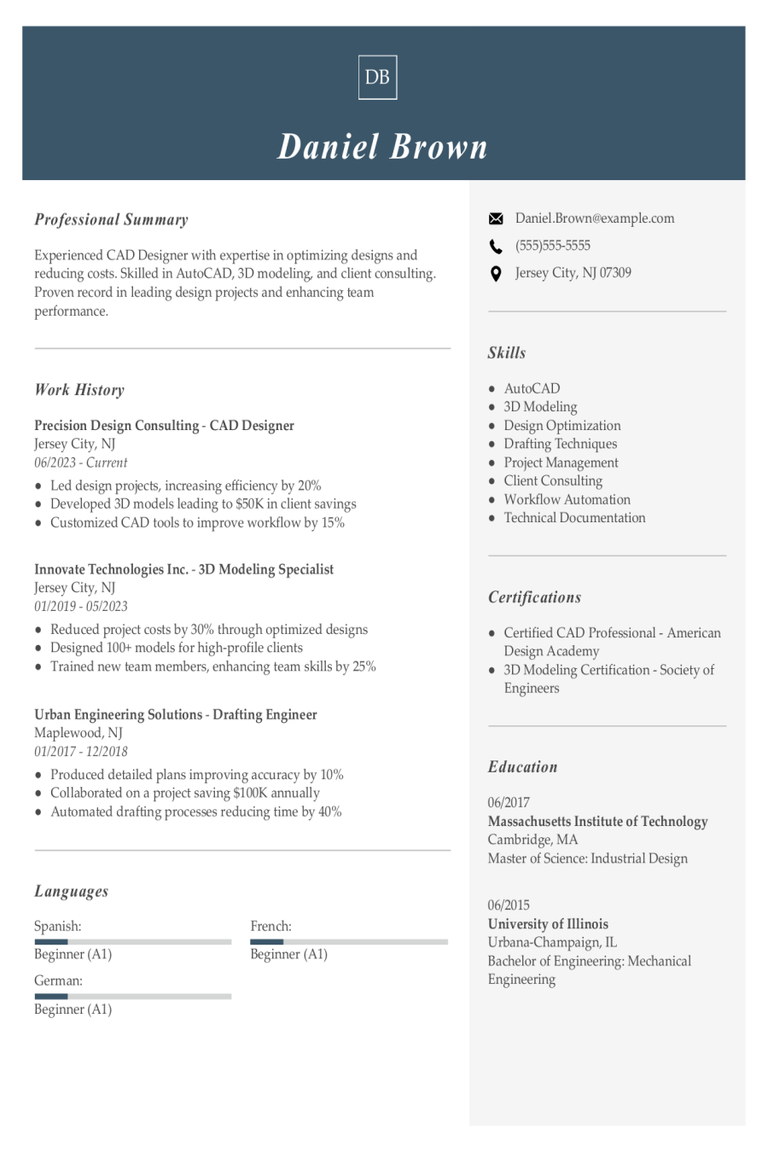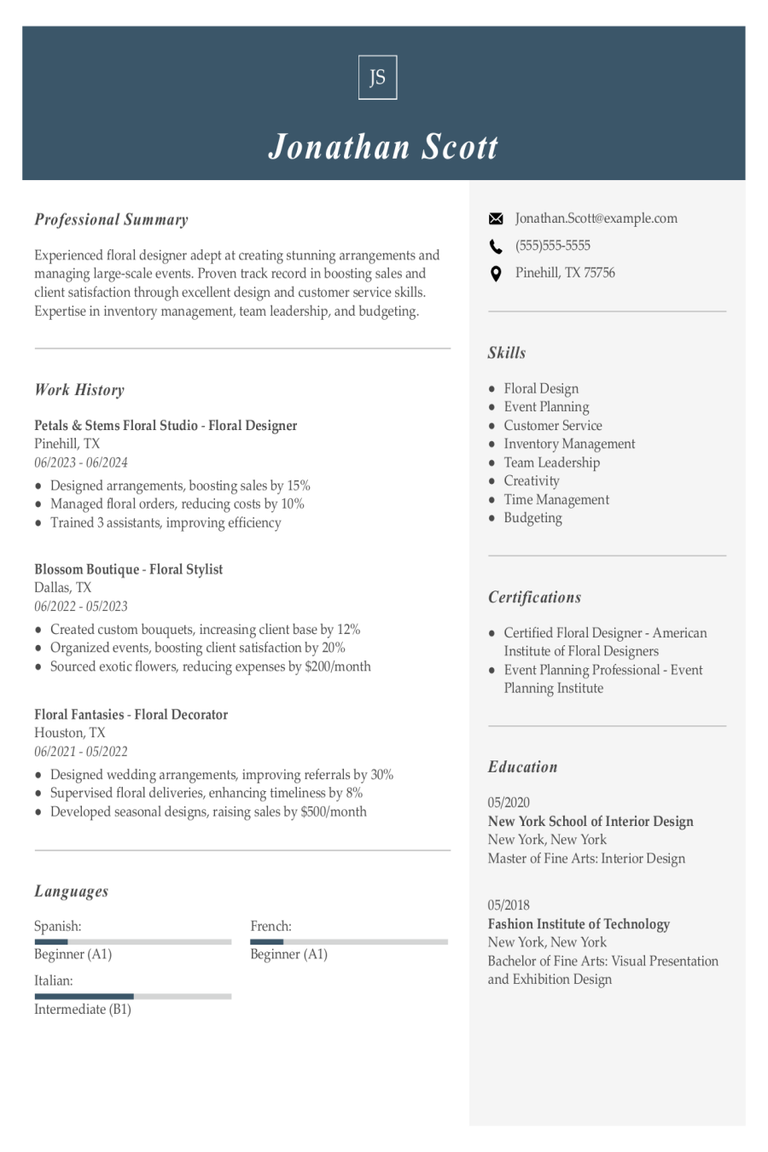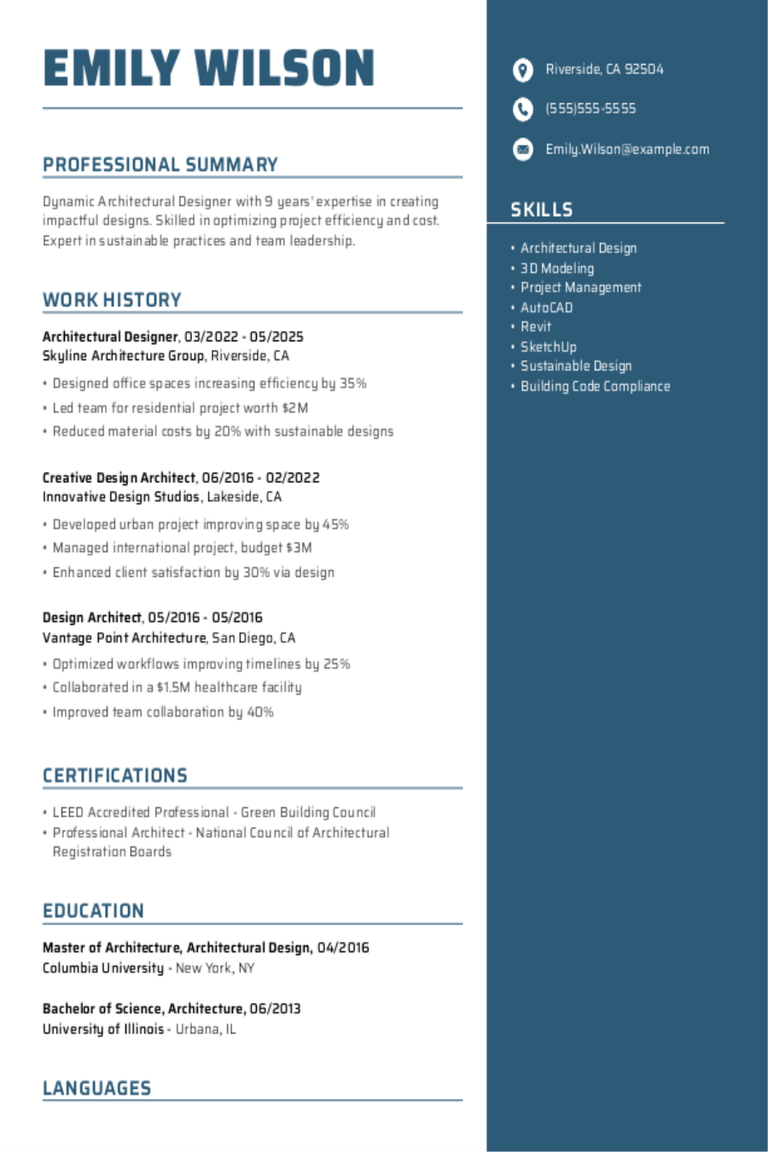Why this resume works
- Quantifies accomplishments: By referencing measurable accomplishments like a 30% increase in client satisfaction, the applicant illustrates impact and value.
- Showcases career progression: The applicant’s journey from garden designer to landscape designer shows a clear trajectory of increased responsibility and expertise in design projects worth over $1M.
- Highlights industry-specific skills: Skills such as sustainable practices and urban planning show the applicant’s fit for roles focused on eco-friendly and efficient design solutions.
More Landscape Designer Resume Examples
Discover resume examples for landscape designers that emphasize creativity, project management, and sustainability. Use these landscaping resume samples to craft a resume showcasing your skills and experience in designing outdoor spaces effectively.
Entry-Level Landscape Designer
Why this resume works
- Effective use of keywords: Strategically weaving in industry-specific terms like “plant identification” and “sustainable design,” the applicant ensures alignment with keywords that improve ATS compatibility.
- Shows digital literacy: The resume reflects computer skills by emphasizing tools such as AutoCAD and Adobe Creative Suite, indicating readiness for modern design demands.
- Centers on academic background: Emphasizing academic credentials like a Master’s degree in landscape architecture from the University of Washington highlights a solid foundation, important for someone early in their career.
Mid-Level Landscape Designer
Why this resume works
- Points to measurable outcomes: By showcasing achievements like increasing client satisfaction by 25%, the applicant paints a clear picture of their powerful contributions to landscape design projects.
- Demonstrates language abilities: Language skills in Spanish, French, and German indicate the applicant’s ability for cross-cultural communication in diverse work environments.
- Includes a mix of soft and hard skills: A mix of technical expertise and interpersonal skills is evident, balancing analytical prowess with strong client relations.
Experienced Landscape Designer
Why this resume works
- Showcases impressive accomplishments: By designing innovative park revitalizations and securing $5M for green projects, the applicant reflects a transformative impact on urban landscapes.
- Focuses on work history: The chronological resume format effectively highlights extensive career growth, showcasing a steady advancement from garden design specialist to senior landscape designer.
- Emphasizes leadership skills: The applicant managed teams across multiple roles, trained junior architects, and led site inspections, demonstrating strong leadership skills.
Landscape Designer Resume Template (Text Version)
Jin Lee
Hillcrest, NY 11509
(555)555-5555
Jin.Lee@example.com
Professional Summary
Dynamic Landscape Designer with 9 years experience. Expertise in sustainable practices and urban planning. Proven track record in boosting client satisfaction and managing large-scale projects efficiently.
Work History
Landscape Designer
GreenScape Innovations – Hillcrest, NY
January 2022 – September 2025
- Designed 50+ landscape projects annually.
- Increased client satisfaction by 30% with unique designs.
- Reduced project costs by 15% through efficient planning.
Landscape Architect
EcoLand Designs – Buffalo, NY
January 2018 – December 2021
- Led team of 10 in complex design projects.
- Developed sustainable practices reducing waste by 20%.
- Collaborated on urban park project worth $1M.
Garden Designer
BloomScape Solutions – Hillcrest, NY
January 2016 – December 2017
- Crafted residential garden plans for 100+ clients.
- Boosted customer referrals by 40% via standout designs.
- Optimized plant selection process cutting costs by 25%.
Languages
- Spanish – Beginner (A1)
- French – Intermediate (B1)
- Italian – Beginner (A1)
Skills
- Landscape Design
- Urban Planning
- Sustainable Practices
- Project Management
- AutoCAD
- Client Relations
- Design Software
- Budget Management
Certifications
- Certified Landscape Architect – American Society of Landscape Architects
- LEED Green Associate – U.S. Green Building Council
Education
Master of Landscape Architecture Landscape Design
University of Oregon Eugene, OR
June 2015
Bachelor of Science Horticulture
Oregon State University Corvallis, OR
June 2013
Related Resume Guides
Advice for Writing Your Landscape Designer Resume
Check out our tips on how to write a resume that highlights your creativity, design skills, and passion for transforming outdoor spaces. Discover how to tailor your experience and make your unique talents shine.
Showcase your portfolio or projects
For a landscape designer, having a well-organized portfolio or projects on your resume is essential. It lets potential employers or clients see your creative vision and skills in action.
By including a link to an online portfolio on platforms like Behance, Dribbble, or a personal website, you make it easy for them to explore your work. This is important because visual examples of your work demonstrate what you can do far better than words alone.
When building your portfolio, don’t forget to include freelance work, academic projects, and side projects. These experiences show the range of your abilities and creativity. Each project should be detailed just like job entries on your resume: list the project name, client or company (if applicable), give a brief description, and note key contributions and impact.
For example, if you designed a public park layout that improved community engagement, mention that along with any feedback or outcomes received from the community. These details help tell the story of what you accomplished and how it made a difference.
By following these tips for showcasing projects effectively, you’ll create a compelling presentation that highlights your talents as a landscape designer and makes you stand out in artistic fields.
Example of a projects section
Sustainable Garden Design for Urban Park
Green City Initiative
March 2023 – July 2023
- Developed a sustainable garden layout incorporating native plants to promote biodiversity.
- Collaborated with city planners to ensure compliance with environmental regulations.
- Installed eco-friendly irrigation systems, reducing water usage by 30%.
Rooftop Terrace Landscape Transformation
Skyview Residences
August 2022 – February 2023
- Transformed an unused rooftop space into a vibrant community garden and seating area.
- Selected plant species that thrive in high-altitude conditions, improving aesthetic appeal.
- Coordinated with structural engineers to integrate planters without compromising building integrity.
Need help getting started on your resume? Check out our professional resume examples to see how others show their skills and experience.
Emphasize your most relevant skills
For a landscape designer, both technical and soft skills are key. Technical skills like using design software and understanding plant science are necessary for creating beautiful and functional outdoor spaces. Soft skills such as communication, creativity, and problem-solving help in working with clients, understanding their needs, and coming up with innovative designs that meet their expectations.
Include a dedicated skills section on your resume to highlight your abilities clearly. List specific software you can use, such as AutoCAD or SketchUp, along with artistic talents like sketching or color theory. This makes it easy for potential employers to see what you bring to the table at a glance.
To make an even stronger impact, weave these skills into your work experience bullet points. For example, mention how your skill in design software helped you create detailed plans that wowed clients or how your creative problem-solving led to successful project completions. This shows not only what you can do but also how you’ve used these skills effectively in real-world situations.
For landscape designers, a resume format that highlights design skills, project experience, and client satisfaction can improve your application.
Choose a professional resume template
When choosing a resume template for a landscape designer role, look for one that balances creativity and professionalism. Opt for a clean and structured format that showcases your experience and skills without being overly decorative.
A clear visual hierarchy will help your resume stand out while keeping it easy to read. Choosing a format optimized for (applicant tracking systems) ATS is also important. Avoid using complex graphics or unusual fonts, as these can confuse the software and prevent your resume from getting through initial screenings.
Stick with standard sections like “Experience,” “Skills,” and “Education” to ensure all your information is easily accessible. Ensure the template you select highlights your design abilities subtly but effectively. Use simple lines, ample white space, and organized sections to create a professional appearance.
Easily showcase your landscaping skills with our Resume Builder. Choose a design, add your experience, and create a professional resume easily.
Format your resume properly
Ensuring a proper resume format is key to presenting your information in a readable and professional manner. For landscape designers with extensive experience, a chronological resume effectively demonstrates career growth. If you’re new to the field, opt for a functional resume that emphasizes skills more than job history.
5 resume formatting tips
- Choose a professional font: Use a readable resume font like Arial, Calibri, or Times New Roman in 10–12 pt size.
- Organize sections clearly: Separate sections with bold, clear headings (e.g., “work experience” and “skills”) for easy navigation.
- Use bullet points: Break down skills, job duties, and achievements into concise bullet points for readability.
- Stick to one page: If possible, aim for a one-page resume, particularly if you have less than ten years of experience.
- Maintain consistent margins and spacing: Use 1-inch margins and consistent spacing for a polished, professional look.
You can use our ATS Resume Checker to scan your resume for potential issues and receive on-the-spot feedback to improve your resume score.
FAQ
Do I need to include a cover letter with my landscape designer resume?
Including a cover letter with your landscape designer resume can significantly boost your application and improve your chances of landing an interview.
A cover letter gives you the opportunity to express enthusiasm for the role and highlight specific projects or achievements that showcase your design skills and creativity.
If the firm specializes in sustainable landscaping or urban green spaces, you can detail any relevant experience or passion for these areas within your cover letter.
Consider using our Cover Letter Generator to craft a tailored cover letter that complements your resume, showcasing why you’re a perfect fit for the position.
Reviewing various cover letter examples can also provide valuable insights into how to structure and phrase your cover letter effectively.
How long should a landscape designer’s resume be?
For a landscape designer, a one-page resume is often sufficient to highlight your creative skills, relevant software expertise, and hands-on project experience. This format works well if you’re earlier in your career or have fewer projects to showcase.
However, if you possess extensive experience or want to detail complex projects and specialized certifications, a two-page resume can be appropriate. Ensure every project listed adds value and demonstrates your design capabilities effectively.
Explore our guide on how long a resume should be for more tailored advice on selecting the ideal length based on your experience level.
How do you write a landscape designer resume with no experience?
When crafting a resume with no experience for a landscape designer role, it’s important to highlight your relevant skills, education, and any related projects or volunteer work that align with the position. Here are a few tips to help you get started:
- Emphasize your education: Begin with your degree in landscape architecture or a related field. Include your school name, graduation date, and any honors you received.
- Showcase relevant coursework or projects: List courses that provided you with design skills, such as horticulture or CAD design. If you’ve worked on any personal or academic projects, describe them briefly to show the practical application of your skills.
- Highlight transferable skills: Focus on abilities like creativity, attention to detail, and skill in design software. These are important for landscape designers, even if you haven’t had formal job experience yet.
See our guide on writing a resume with no experience for more detailed advice on crafting a resume specifically tailored to entry-level landscape designer positions.
Rate this article
Landscape Designer
Additional Resources

Interior Designer Resume Examples & Templates for 2025
Explore interior designer resume examples to see how to showcase your creativity and project management skills effectively. These examples and tips will help you highlight your design experience and unique

Costume Designer Resume Examples & Templates for 2025
Browse costume designer resume examples and tips to learn how to showcase your experience bringing creative visions to life, working with fabrics, and collaborating with directors.Build my resumeImport existing

Landscape Architect Resume Examples & Templates for 2025
Explore landscape architect resume examples and tips to learn how to showcase your project management skills and experience with site planning, client collaboration, and sustainable solutions.Build my resumeImport existing resumeCustomize

CAD Designer Resume Examples & Templates for 2025
Discover how to craft a standout CAD designer resume with our samples and tips. Learn to showcase your design skills, software knowledge, and project experience to catch the attention of

Floral Designer Resume Examples & Templates for 2025
Discover how floral designers showcase creativity and design skills in their resumes. Use these examples and tips to learn how to highlight your floral arrangement, customer service, and event planning

Architectural Designer Resume Examples & Templates for 2025
Explore architectural designer resume examples that show how to highlight your creativity, technical skills, and experience with design software.Build my resumeImport existing resumeCustomize this templateWhy this resume worksQuantifies accomplishments: The applicant’s
